Numerical Investigation on Dynamic Response of RC T-Beams Strengthened with CFRP under Impact Loading
Abstract
:1. Introduction
2. Review of the Available Experimental Procedure
3. Numerical Model of RC T-Beams Strengthened with CFRP
3.1. Finite Element Model
3.2. Constitutive Model and Material Parameters
4. Validation and Analysis
4.1. Impact Force and Reaction Force
4.2. Displacement
4.3. Fracture Development Process and Failure Mode
4.4. Section Damage Assessment
5. Parametric Study
5.1. Strengthening Effect of FRP
5.2. Effect of Strengthening Modes
5.3. Effect of Strengthening Sizes
5.4. Effect of Strengthening Layers
5.5. Effect of Strengthening Material Types
6. Conclusions
Author Contributions
Funding
Conflicts of Interest
References
- Teng, J.G.; Ye, L.P. New Composite Materials and Structures; Science Press: Beijing, China, 2006; Volume 7, pp. 177–192. [Google Scholar]
- Zhu, K.J. Experimental Analysis on the Impact Resistance Performance of RC Beams Strengthened with Externally Bonded AFRP Fabric. Master’s Thesis, Henan Polytechnic University, Jiaozuo, China, 2014. [Google Scholar]
- Chen, J.F.; Teng, J.G. Shear capacity of FRP-strengthened RC beams: FRP debonding. Constr. Build. Mater. 2003, 17, 27–41. [Google Scholar] [CrossRef]
- Deng, Z.G.; Zhang, P.F.; Li, J.H. Fatigue and Static Behaviors of RC Beams Strengthened with Prestressed AFRP. China J. Highw. Transp. 2007, 20, 49–55. [Google Scholar]
- Pan, J.L.; Chen, Z.F.; Liang, Z.N. Experimental investigation on flexural and flexural/shear crack induced debonding failure in FRP strengthened concrete beams. J. Southeast Univ. (Nat. Sci. Ed.) 2007, 37, 229–234. [Google Scholar]
- Chen, G.M.; Teng, J.G.; Chen, J.F. Process of debonding in RC beams shear-strengthened with FRP U-strips or side strips. Int. J. Solids Struct. 2012, 49, 1266–1282. [Google Scholar] [CrossRef] [Green Version]
- Dong, J.; Wang, Q.; Guan, Z. Structural behaviour of RC beams with external flexural and flexural–shear strengthening by FRP sheets. Compos. Part B Eng. 2013, 44, 604–612. [Google Scholar] [CrossRef]
- Tang, T.; Saadatmanesh, H. Behavior of concrete beams strengthened with fiber-reinforced polymer laminates under impact loading. J. Compos. Constr. 2003, 209–218. [Google Scholar] [CrossRef]
- Saadatmanesh, H.; Tang, T. Analytical and Experimental Studies of Fiber-Reinforced Polymer-Strengthened Concrete Beams Under Impact Loading. ACI Struct. J. 2005, 102, 139–149. [Google Scholar]
- Soleimani, S.M.; Banthia, N.; Mindess, S. Sprayed GFRP shear-strengthened reinforced concrete Beams under Impact Loading. Adv. Constr. Mater. 2007, 279–286. [Google Scholar] [CrossRef]
- Pham, T.M.; Hao, H. Impact behavior of FRP-strengthened RC beams without stirrups. J. Compos. Constr. 2016, 20, 1–13. [Google Scholar] [CrossRef]
- Pham, T.M.; Hao, H. Behavior of fiber-reinforced polymer-strengthened reinforced concrete beams under static and impact loads. Int. J. Prot. Struct. 2017, 8, 3–24. [Google Scholar] [CrossRef]
- Liu, T.; Xiao, Y. Impact Behavior of CFRP-Strip-Wrapped RC Beams without Stirrups. J. Compos. Constr. 2017, 21, 37–43. [Google Scholar] [CrossRef]
- Bhatti, A.Q.; Kishi, N.; Mikami, H.; Anto, T. Elasto-plastic impact response analysis of shear-failure-type RC beams with shear rebars. Mater. Des. 2009, 30, 502–510. [Google Scholar] [CrossRef]
- Bhattia, A.Q.; Kishi, N. Impact response of RC rock-shed girder with sand cushion under falling load. Nucl. Eng. Des. 2010, 240, 2626–2632. [Google Scholar] [CrossRef]
- Tu, Z.; Lu, Y. Evaluation of typical concrete material models used in hydrocodes for high dynamic response simulations. Int. J. Impact Eng. 2009, 36, 132–146. [Google Scholar] [CrossRef]
- Meng, Y.; Yi, W.J. Dynamic behavior of concrete cylinder specimens under low velocity impact. J. Vib. Shock 2011, 30, 205–210. [Google Scholar]
- Meng, Y. Experiment and Numerical Simulation Study on Reinforced Concrete Beam under Impact Loading. Ph.D. Thesis, Hunan University, Changsha, China, 2012. [Google Scholar]
- Meng, Y.; Hang, F.L. Numerical simulation study on dynamic behavior of concrete cylinder under drop hammer impact loading. J. Railw. Sci. Eng. 2017, 14, 2427–2434. [Google Scholar]
- Pham, T.M.; Hao, H. Plastic hinges and inertia forces in RC beams under impact loads. Int. J. Impact Eng. 2017, 103, 1–11. [Google Scholar] [CrossRef] [Green Version]
- Zhao, W.C.; Qian, J.; Zhang, W.N. Performance and damage assessment of reinforced concrete beams under impact loading. Explos. Shock Waves 2019, 39, 111–122. [Google Scholar]
- Liu, J.T. Experimental Study on Shear Behavior of RC T Beams without Stirrups Strengthened with CFRP Sheets under Impact Loading. Master’s Thesis, Hunan University, Changsha, China, 2016. [Google Scholar]
- Murray, Y.D. Users Manual for LS-DYNA Concrete Material Model 159. Report No. FHWA-HRT-05-062; Federal Highway Administration: McLean, VA, USA, 2007. [Google Scholar]
- Zeng, X. Experimental and Numerical Study of Behaviors of RC Beams and Columns under Impact Loadings and Rapid Loadings; Hunan University: Changsha, China, 2014. [Google Scholar]
- Zhao, S.Y.; Xue, P. New two-dimensional polynomial failure criteria for composite materials. Adv. Mater. Sci. Eng. 2014, 2014, 1–7. [Google Scholar] [CrossRef] [Green Version]
- Yang, L.; Yan, Y.; Kuang, N. Experimental and numerical investigation of aramid fibre reinforced laminates subjected to low velocity impact. Polym. Test. 2013, 32, 1163–1173. [Google Scholar] [CrossRef]
- Mou, H.L.; Zhou, T.C.; Feng, Y.F.; Feng, Z.Y. Experiment and Simulation of Composite Corrugated Plate under Quasi-static Crushing and Analysis of Material Model Parameters. Mech. Sci. Technol. Aerosp. Eng. 2015, 34, 618–622. [Google Scholar]
- Han, H.; Taheri, F.; Pegg, N.; Lu, Y. A numerical study on the axial crushing response of hybrid pultruded and ±45° braided tubes. Compos. Struct. 2007, 80, 253–264. [Google Scholar] [CrossRef]
- Al-Zubaidy, H.; Zhao, X.L.; Al-Mahaidi, R. Mechanical Characterisation of the Dynamic Tensile Properties of CFRP Sheet and Adhesive at Medium Strain Rates. Compos. Struct. 2013, 96, 153–163. [Google Scholar] [CrossRef]
- Zhang, X.H.; Hao, H.; Shi, Y.C.; Cui, J.; Zhang, X. Static and Dynamic Material Properties of CFR/Epoxy Laminates. Constr. Build. Mater. 2016, 114, 638–649. [Google Scholar] [CrossRef] [Green Version]
- Rodriguez-Nikl, T.; Lee, C.S.; Hegemier, G.A.; Seible, F. Experimental performance of concrete columns with composite jackets under blast loading. J. Struct. Eng. 2012, 138, 81–89. [Google Scholar] [CrossRef] [Green Version]
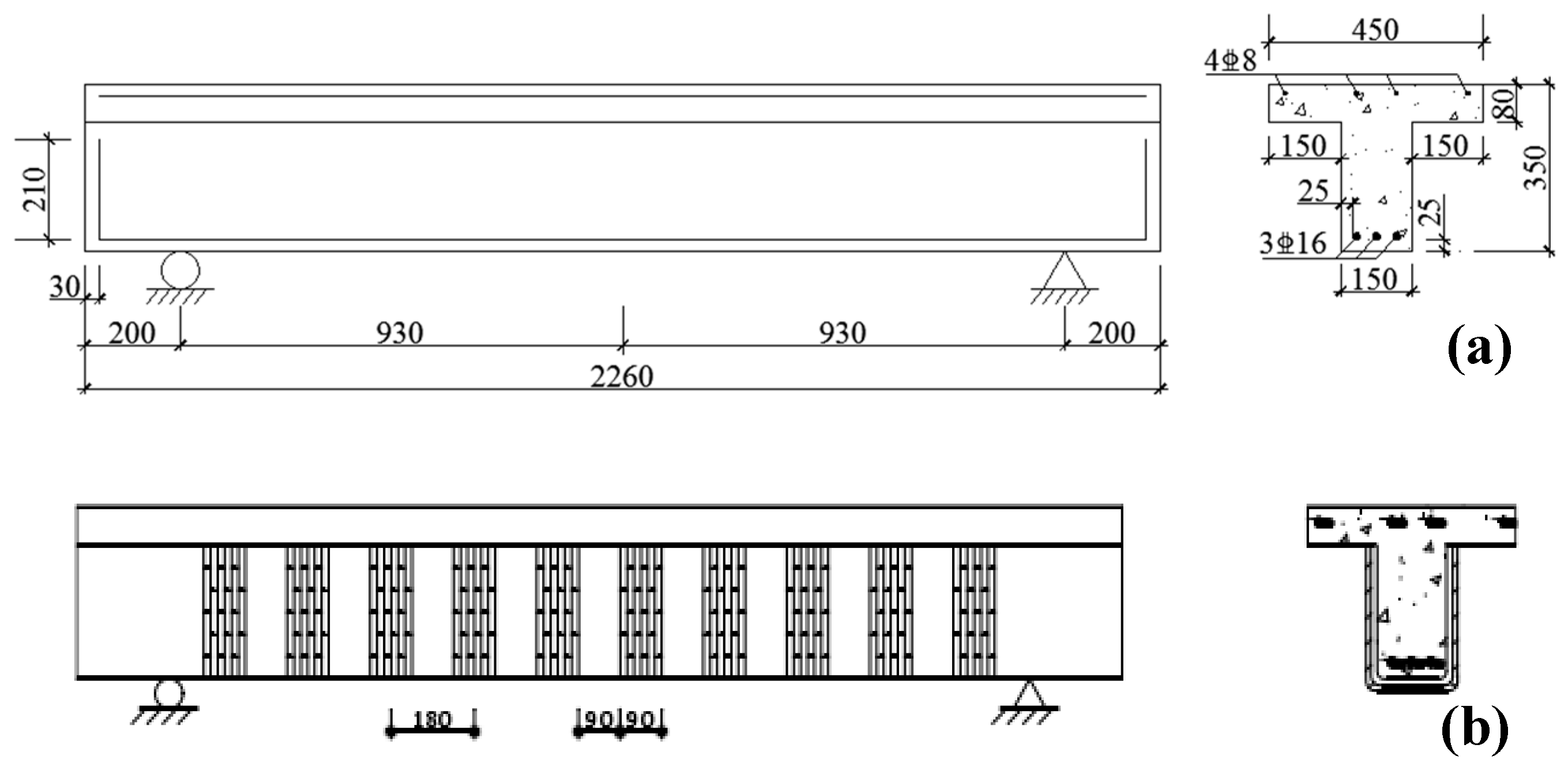
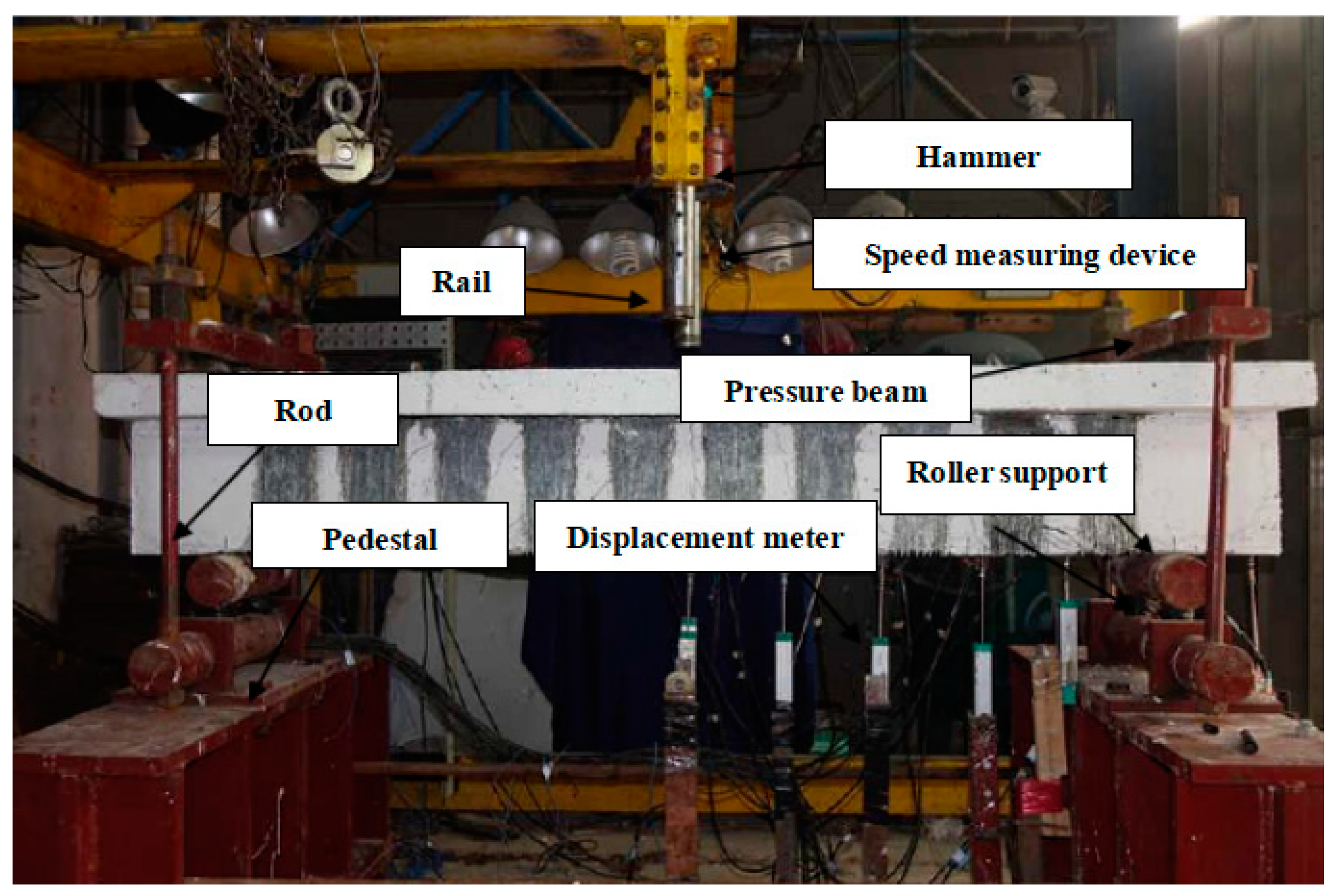


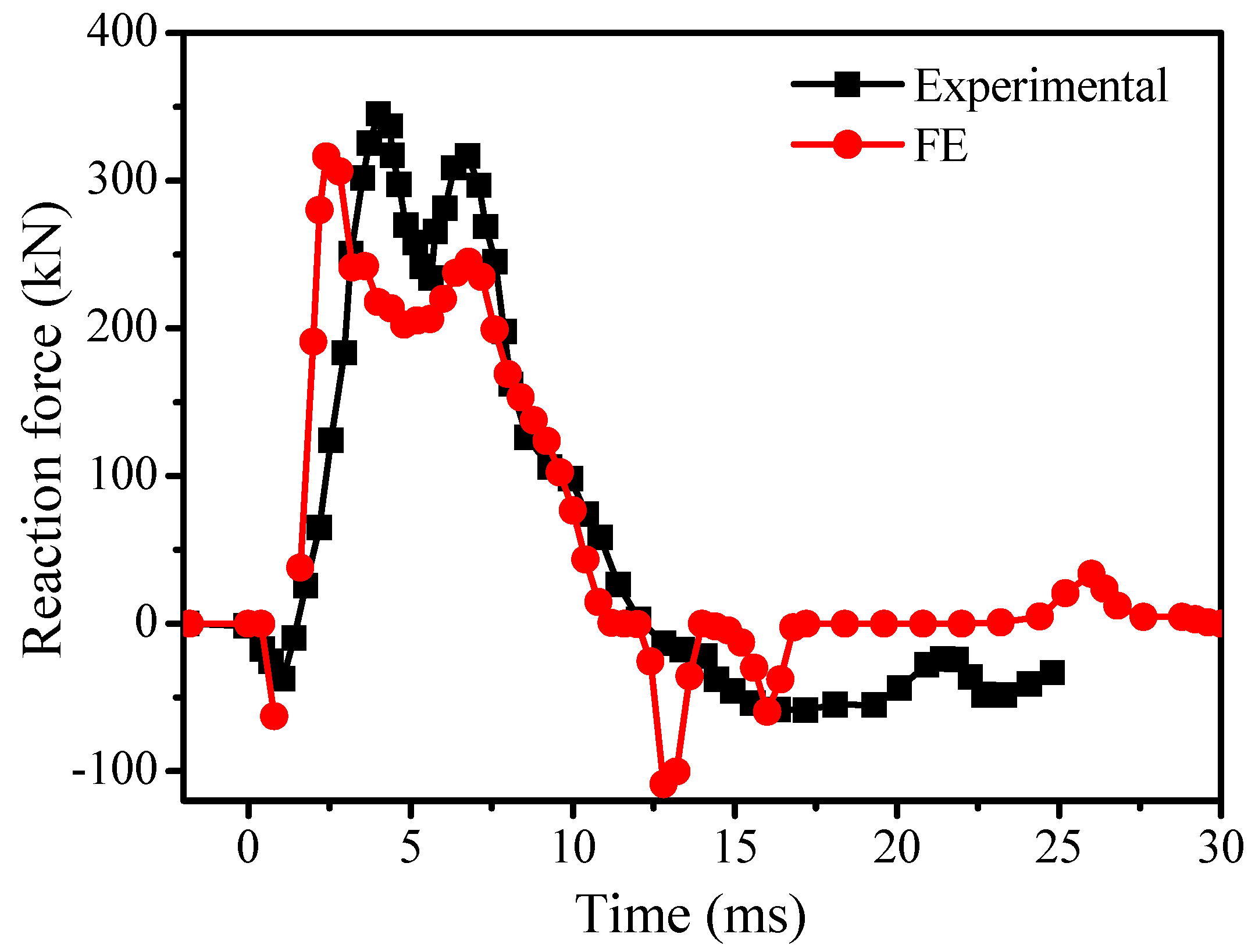
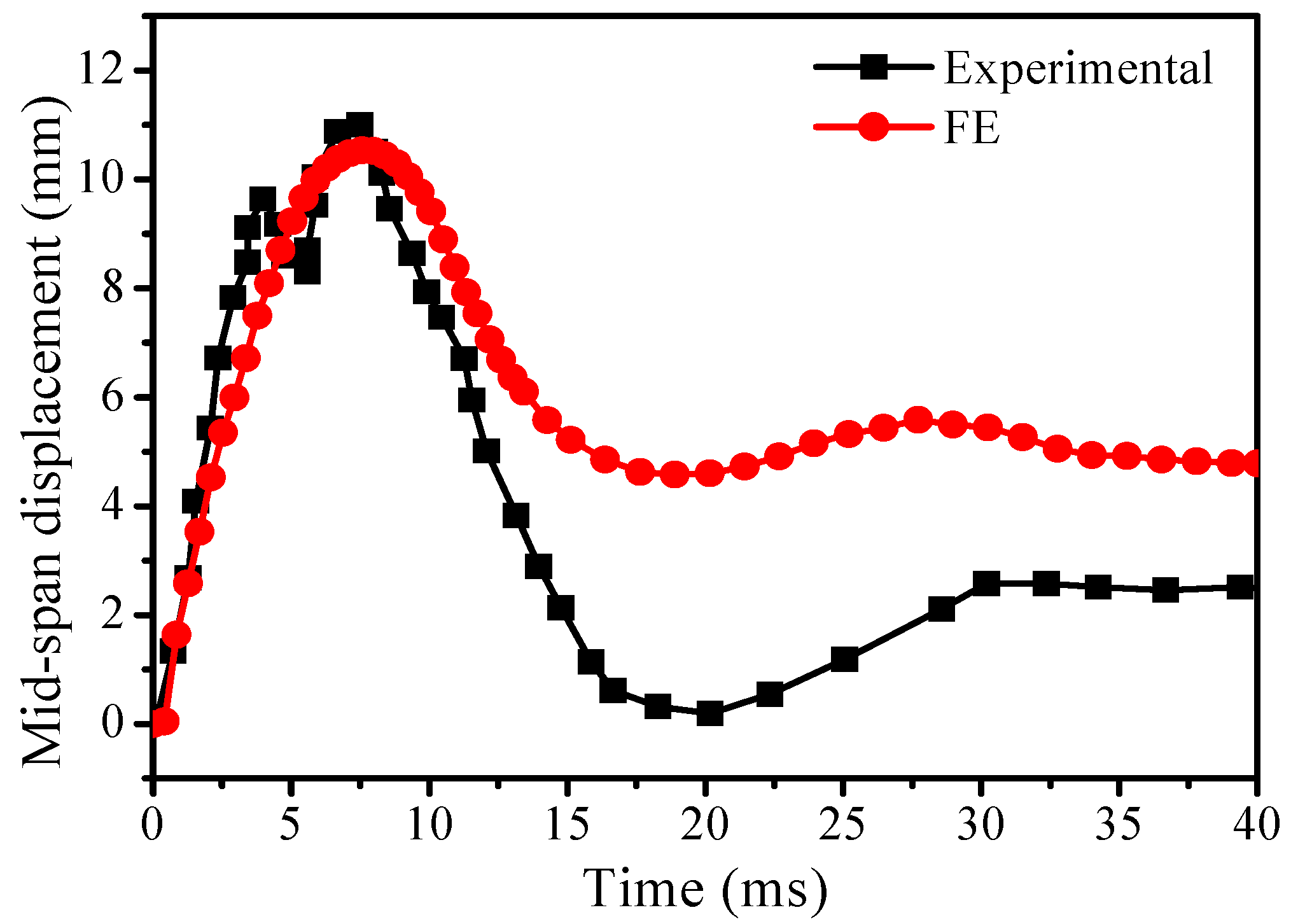
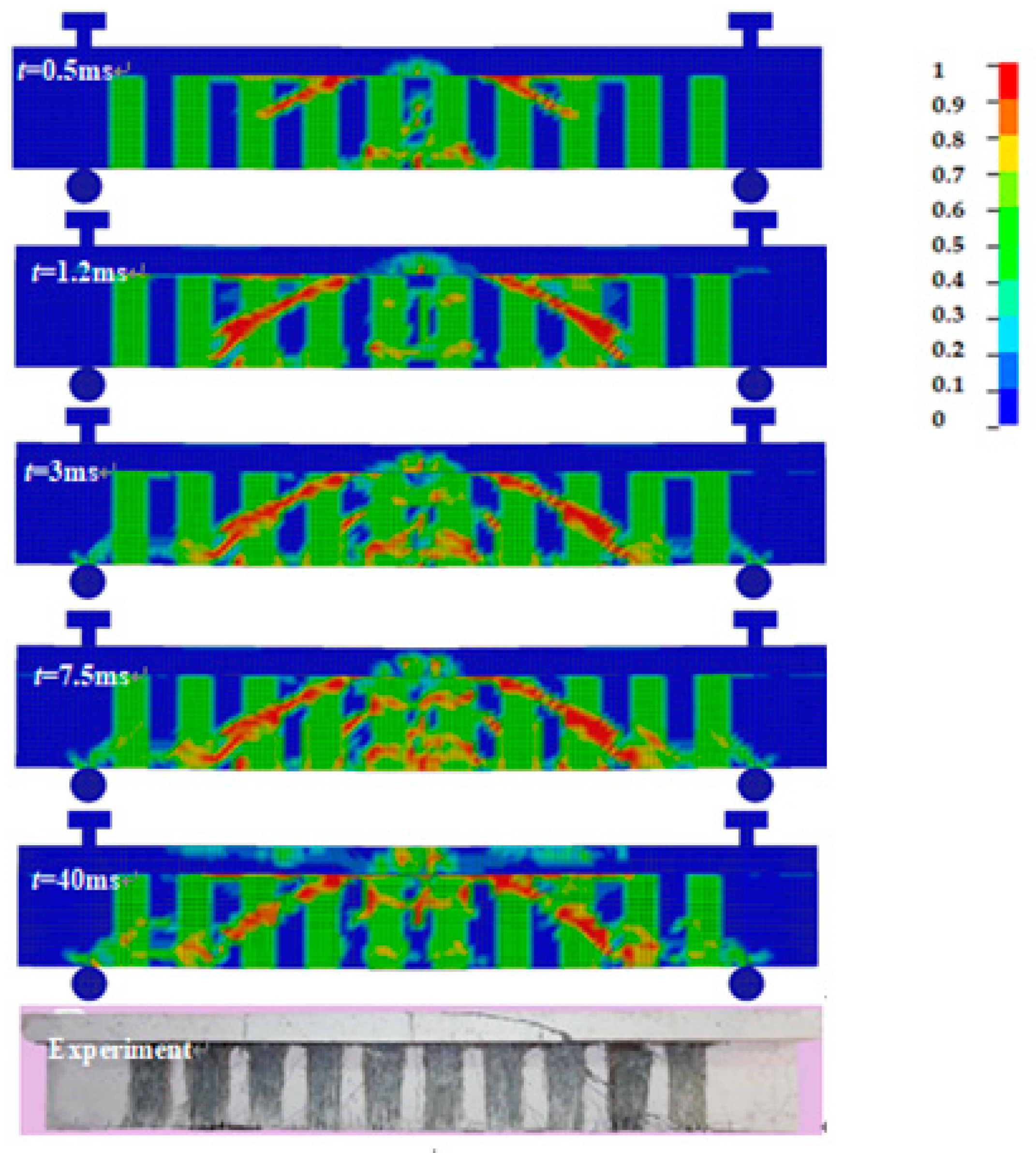
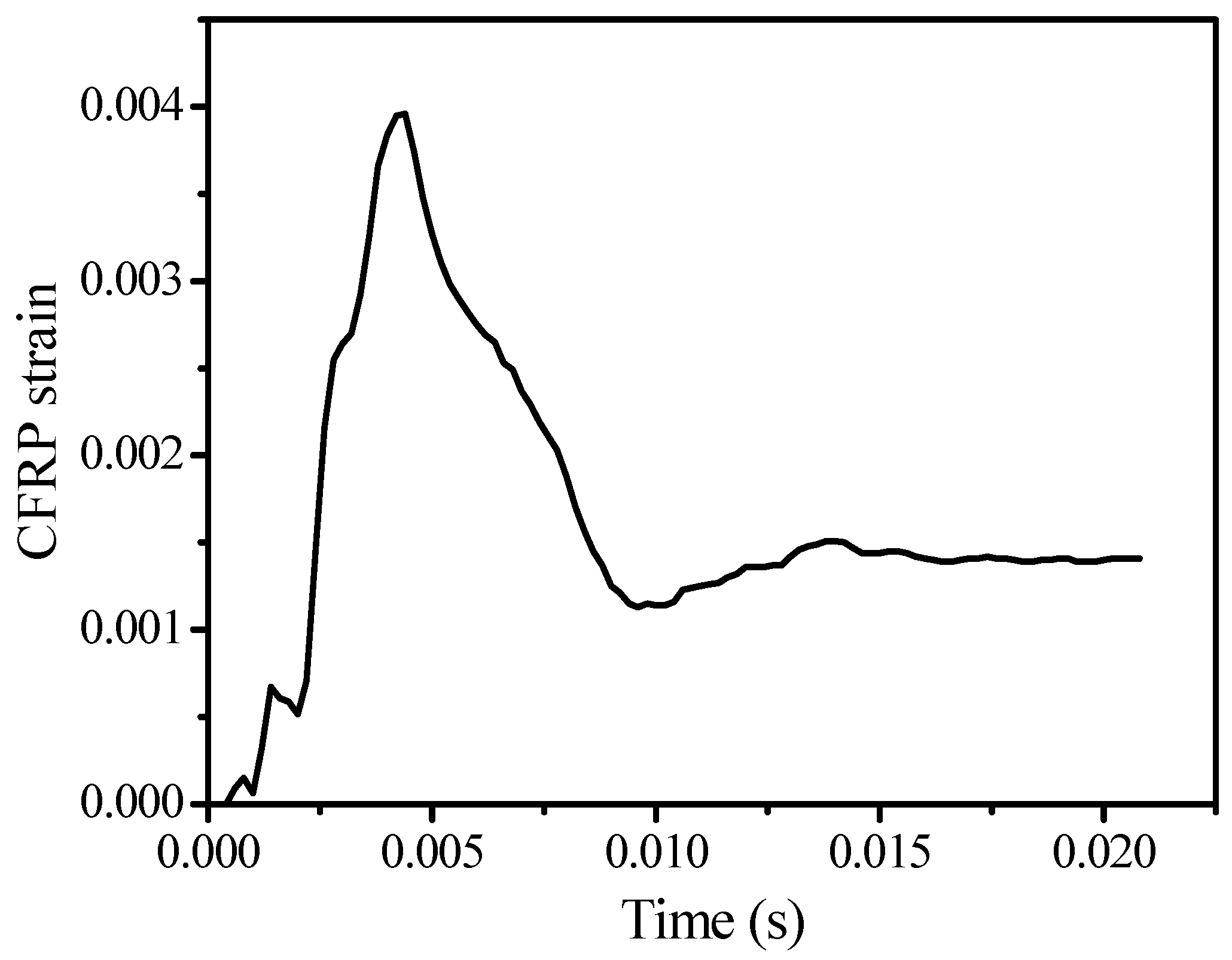

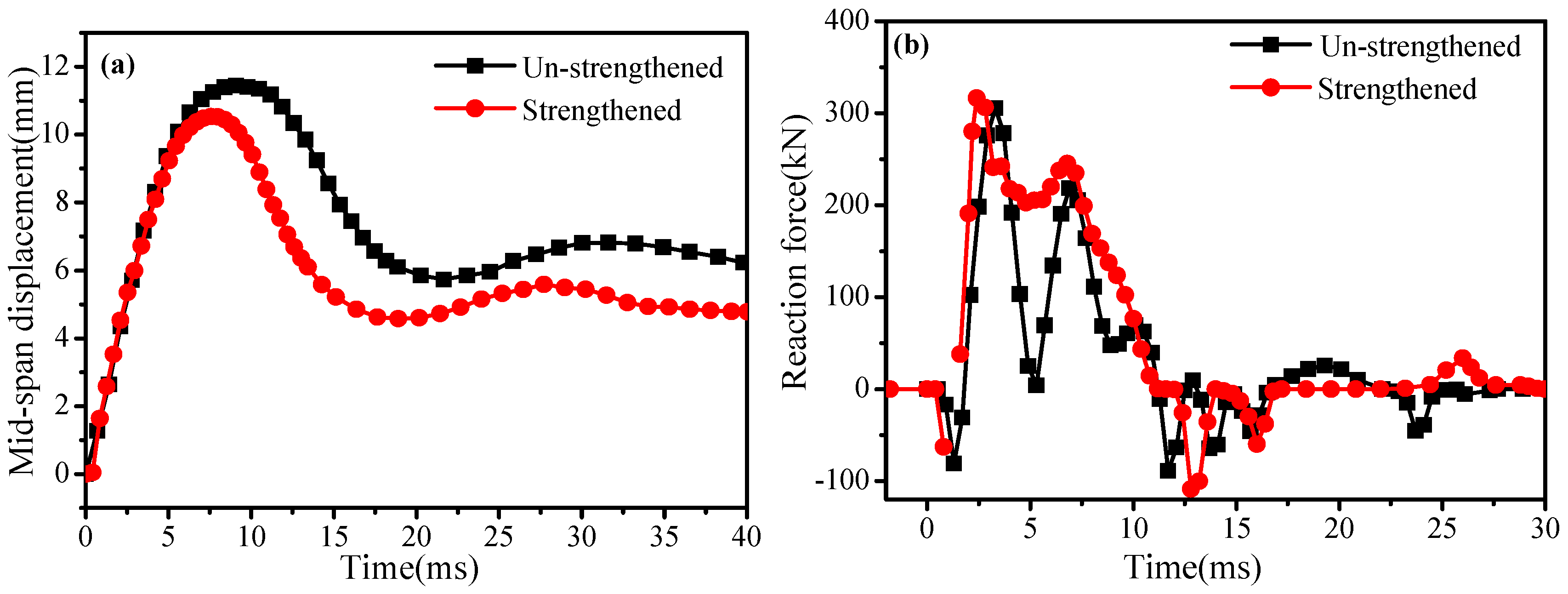
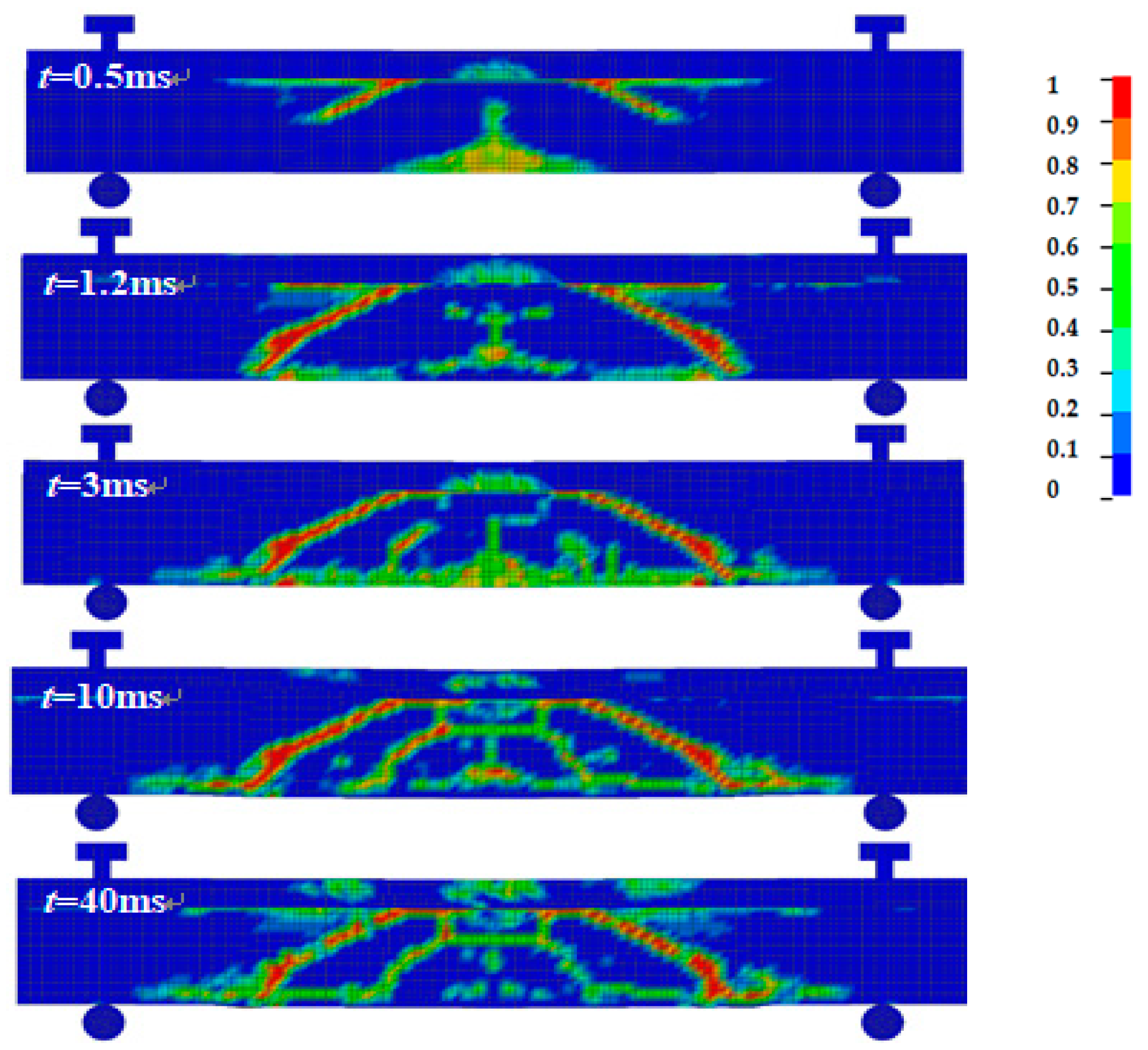




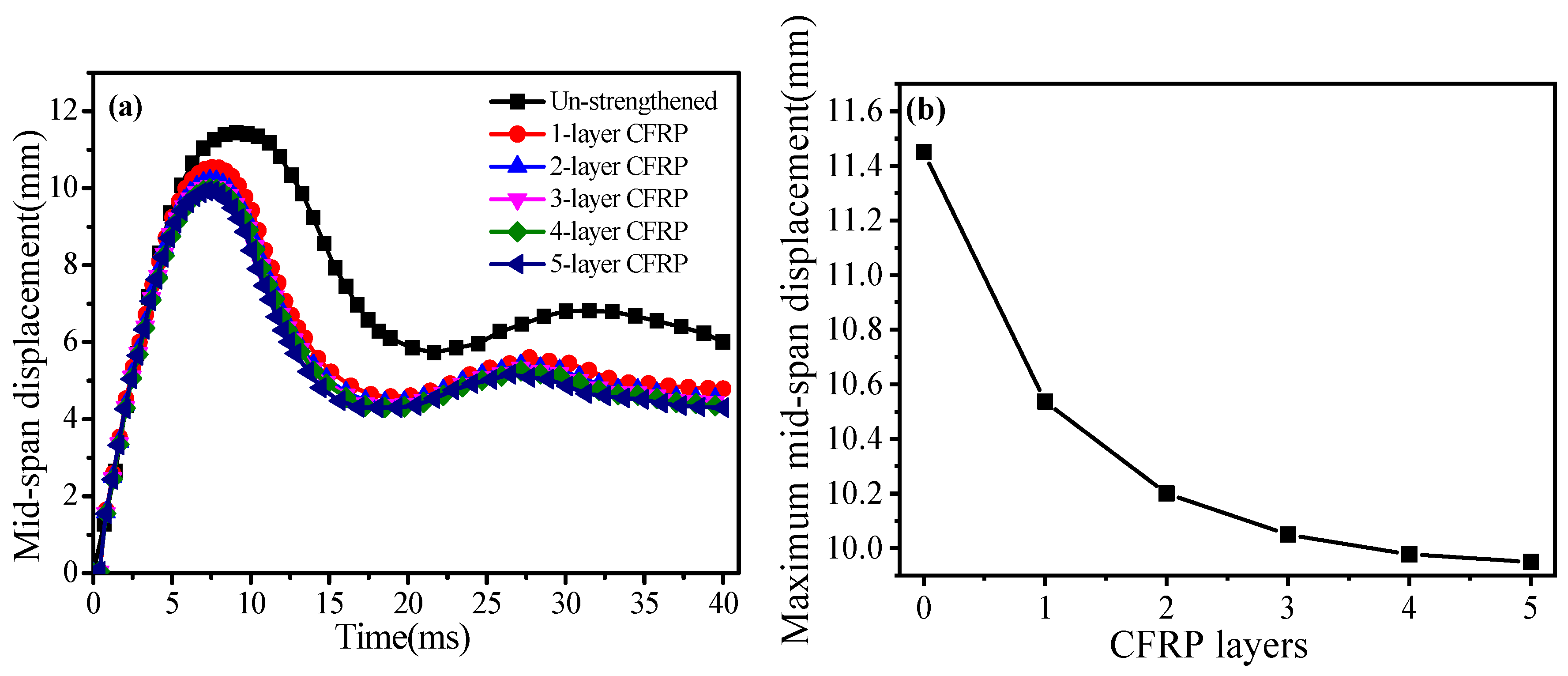

| Density RO (ton·mm−3) | Calculated Control Parameters NPLOT | Maximum Strain Increment INCRE | Strain Rate Switch IRATE | Unit of Erosion ERODE | Pressure Recovery Parameter RECOV | Cap Options IRETRC | Pre-Damage PRED | Uniaxial Compressive Strength f’c (MPa) | Largest Aggregate Diameter DAGG (mm) |
|---|---|---|---|---|---|---|---|---|---|
| 2.4 × 10−9 | 1 | 0 | 1 | 1.4 | 0 | 0 | 0 | 25 | 15 |
| Density RO (ton·mm−3) | Elastic Modulus E (MPa) | Poisson Ratio PR (MPa) | Yield Strength SIGY (MPa) | Tangent Modulus ETAN (MPa) | Hardening Parameter BETA | Strain Rate Parameter SRC | Strain Rate Parameter SRP | Failure Strain FS |
|---|---|---|---|---|---|---|---|---|
| 7.8 × 10−7 | 2 × 105 | 0.3 | 477 | 2 × 103 | 0 | 40.4 | 5 | 0.12 |
| Material Parameters | CFRP | AFRP | GFRP |
|---|---|---|---|
| Density ρ (ton·mm−3) | 1.53 × 10−9 | 1.44 × 10−9 | 1.80 × 10−9 |
| Longitudinal modulus of elasticity Ea (MP) | 1.28 × 105 | 6.7 × 104 | 3.09 × 104 |
| Transverse modulus for composite Eb (MPa) | 8.4 × 103 | 4.7 × 103 | 8.3 × 103 |
| Poisson’s ration νba | 0.0218 | 0.0280 | 0.0866 |
| In-plane shear modulus Gab (MPa) | 4.0 × 103 | 2.0 × 103 | 2.8 × 103 |
| Traverse shear modulus Gbc (MPa) | 4.0 × 103 | 1.586 × 103 | 2.8 × 103 |
| Longitudinal shear modulus Gca (MPa) | 4.0 × 103 | 1.586 × 103 | 2.8 × 103 |
| Longitudinal compressive strength Xc (MPa) | 1060 | 312 | 480 |
| Longitudinal tensile strength Xt (MPa) | 2093 | 1420 | 983 |
| Transverse compressive strength Yc (MPa) | 198 | 145 | 140 |
| Transverse tensile strength Yt (MPa) | 50 | 36 | 40 |
| In-plane shear strength Sc (MPa) | 104 | 53 | 70 |
| Strengthening Modes | FRP Strengthening Sizes (mm2) | FRP Strengthening Layers | FRP Material Types | Maximum Mid-Pan Displacement (mm) | Residual Displacement (mm) |
|---|---|---|---|---|---|
| Un-strengthened | - | 0 | - | 11.44 | 6.23 |
| Model A | 621,000 | 1 | CFRP | 10.54 | 4.78 |
| Model B | 621,000 | 1 | CFRP | 8.31 | 3.17 |
| Model C | 621,000 | 1 | CFRP | 9.07 | 4.55 |
| Model D | 621,000 | 1 | CFRP | 9.49 | 4.82 |
| Model A | 372,600 | 1 | CFRP | 10.73 | 5.89 |
| Model A | 869,400 | 1 | CFRP | 9.38 | 4.56 |
| Model A | 1,242,000 | 1 | CFRP | 8.96 | 3.57 |
| Model A | 621,000 | 2 | CFRP | 10.20 | 4.53 |
| Model A | 621,000 | 3 | CFRP | 10.05 | 4.45 |
| Model A | 621,000 | 4 | CFRP | 9.98 | 4.35 |
| Model A | 621,000 | 5 | CFRP | 9.93 | 4.30 |
| Model A | 621,000 | 1 | AFRP | 10.88 | 4.98 |
| Model A | 621,000 | 1 | GFRP | 11.01 | 5.13 |
© 2020 by the authors. Licensee MDPI, Basel, Switzerland. This article is an open access article distributed under the terms and conditions of the Creative Commons Attribution (CC BY) license (http://creativecommons.org/licenses/by/4.0/).
Share and Cite
Zhao, H.; Kong, X.; Fu, Y.; Gu, Y.; Wang, X. Numerical Investigation on Dynamic Response of RC T-Beams Strengthened with CFRP under Impact Loading. Crystals 2020, 10, 890. https://doi.org/10.3390/cryst10100890
Zhao H, Kong X, Fu Y, Gu Y, Wang X. Numerical Investigation on Dynamic Response of RC T-Beams Strengthened with CFRP under Impact Loading. Crystals. 2020; 10(10):890. https://doi.org/10.3390/cryst10100890
Chicago/Turabian StyleZhao, Huiling, Xiangqing Kong, Ying Fu, Yihan Gu, and Xuezhi Wang. 2020. "Numerical Investigation on Dynamic Response of RC T-Beams Strengthened with CFRP under Impact Loading" Crystals 10, no. 10: 890. https://doi.org/10.3390/cryst10100890
APA StyleZhao, H., Kong, X., Fu, Y., Gu, Y., & Wang, X. (2020). Numerical Investigation on Dynamic Response of RC T-Beams Strengthened with CFRP under Impact Loading. Crystals, 10(10), 890. https://doi.org/10.3390/cryst10100890





